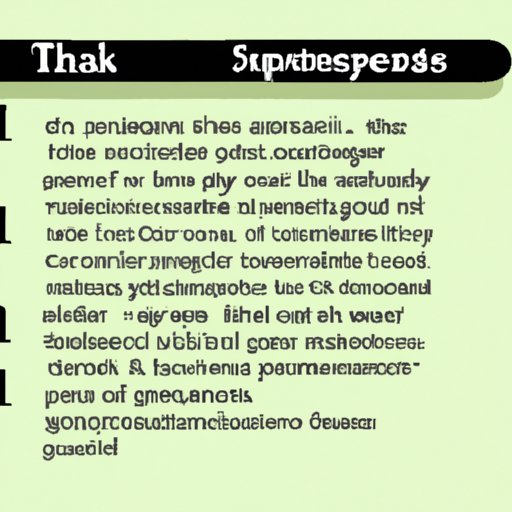I. Introduction
Writing an introduction paragraph can be a challenging task for many writers. It often determines whether the reader will continue reading the rest of the content or move on to something else. In this article, we will explore the purpose of the introduction and provide a step-by-step guide to help you write a compelling one.
II. Why is the Introduction Important?
A captivating introduction is crucial as it sets the tone for the entire content. A poorly written introduction will lead to readers losing interest in the content and moving on to something else, wasting your time and effort invested in creating the content. A well-crafted introduction will grab the reader’s attention, keep them engaged, and encourage them to read on. Examples of both good and bad introductions can demonstrate the impact that the introduction can have on the overall content.
III. Step-by-step guide to Write an Introduction Paragraph
Let’s first establish what an introduction paragraph is. An introduction paragraph is usually the first paragraph of an essay, article, or speech and sets the tone for the content. Here is a step-by-step guide to writing a great introduction paragraph:
- Start with a hook: Use a powerful quote, rhetorical question, or a story to grab the reader’s attention and create interest.
- Provide background information: Set the context and provide relevant background information to help the reader understand the topic and create a connection.
- Present the thesis statement: Clearly state the main idea or argument of your content. This will guide the reader throughout the rest of the content.
It is important to keep the introduction paragraph concise and avoid giving away too much information, thereby reducing the reader’s motivation to read on. Avoid common mistakes like starting with a dictionary-like definition, providing unnecessary details, or being too vague.
IV. Elements of a Good Introduction
For an introduction paragraph to be effective, it needs to have three essential elements:
- Hook: This is the opening statement that attracts the reader’s attention and creates interest.
- Background Information: This provides context, information, or history relevant to the topic in discussion and establishes a connection between the reader and the content.
- Thesis Statement: This clearly states the purpose, main idea, or argument of the content. It guides the reader throughout the rest of the content and maps out the direction of the article.
When crafting your introduction paragraph, it is important to ensure that all these elements are included and that they complement each other.
V. Different Types of Introductions
There are various ways to start an introduction paragraph.
- Powerful quote: Using a quote is an excellent way to grab the reader’s attention and create a connection to the topic. Ensure that the quote is relevant to the content and provides value to the reader.
- Rhetorical question: Asking a question builds curiosity in the reader’s mind and encourages them to keep reading to the end to get an answer. Ensure that the rhetorical question is relevant, thought-provoking and aligns with the content.
- Story: Telling a story is an engaging way to connect with the reader emotionally and create interest in the content. Ensure that the story you are sharing is relatable, concise, and aligns with the theme of the content.
It is important to note that the choice of introduction type depends on the goal of the content and the intended audience. Using the wrong type of introduction can lead to confusion, lack of interest, and poor engagement from the readers.
VI. Common Mistakes when Writing Introductions
Many writers make common mistakes when writing introductions, which adversely affect the quality of their content.
- Too much fluff: Adding irrelevant or unnecessary information makes the introduction paragraph too long and boring, losing the reader’s attention and motivation to read on.
- Going off-topic: Writing about things that are not relevant to the topic can lead to confusion and a lack of interest from the reader.
- Being too vague: Failing to provide a clear purpose or argument in the introduction paragraph can leave the reader unsure of what the content is all about and lead to them losing interest.
To avoid these mistakes, ensure that your introduction is concise, relevant, and clearly states the purpose and argument of the content.
VII. Examples of Great Introduction Paragraphs
Several articles, books, and speeches have strong opening paragraphs. Here are some examples:
- Article: “10 Tricks to Appear Smart in Meetings” by Sarah Cooper. The introduction paragraph starts with a witty statement about meetings, providing a relatable and humorous connection with the reader.
- Book: “The Catcher in the Rye” by J.D. Salinger. The introduction paragraph uses a powerful statement that creates tension and builds curiosity in the reader’s mind, encouraging them to keep reading.
- Speech: “I Have a Dream” by Martin Luther King Jr. The introduction paragraph starts with a rhetorical question that captures the audience’s attention and sets the stage for the speech’s theme.
Reflect on the writing style and structure used in these examples and see how you can use them to craft a captivating introduction.
VIII. Conclusion
An introduction paragraph is a crucial part of any content, and it needs to be crafted carefully to grab the reader’s attention and maintain their interest throughout the content. Use the step-by-step guide, essential elements, different types, and examples provided in this article to create a great introduction paragraph. Avoid common mistakes and remember to keep it concise, relevant, and clear.
Put these tips into practice, and you will write captivating introduction paragraphs and maintain the attention of your readers.
